Managing heart disease with IV milrinone
Understanding IV Milrinone in Heart Disease Care
Intravenous (IV) milrinone plays a crucial role in the management of advanced heart failure. As a phosphodiesterase III inhibitor, it offers unique benefits by improving cardiac performance through positive inotropic and vasodilatory effects. This article explores its mechanisms, clinical applications, safety considerations, and protocols to optimize patient outcomes.
Primary Use of IV Milrinone in Heart Failure
What is the primary use of IV milrinone in heart failure management?
The main purpose of administering intravenous milrinone in patients with heart failure is to provide rapid inotropic support and improve overall blood flow. It works by increasing the strength of the heart's contractions and simultaneously dilating blood vessels.
Milrinone achieves these effects through inhibition of an enzyme called phosphodiesterase III (PDE-III). This inhibition leads to an accumulation of a messenger molecule called cyclic AMP (cAMP) inside heart and blood vessel cells. Increased cAMP levels enhance calcium entry into heart muscle cells, boosting contractility. Additionally, cAMP promotes better relaxation of the heart muscle (lusitropy), aiding in improved cardiac filling.
Beyond its inotropic action, milrinone's vasodilatory effects decrease systemic vascular resistance and pulmonary pressures. This reduces the workload on the heart by lowering the effort needed to pump blood, which can help alleviate symptoms such as shortness of breath and fatigue.
Given its rapid onset, IV milrinone is particularly useful in acute decompensated heart failure where quick hemodynamic improvements are necessary. It often provides symptomatic relief and helps stabilize patients until further long-term therapies can be optimized.
In summary, IV milrinone's primary role is to support heart function swiftly by enhancing cardiac output and reducing vascular resistance, making it a valuable tool in acute care settings for managing severe heart failure episodes.
Safety and Efficacy Considerations
What are the key safety and efficacy considerations when using IV milrinone?
When administering intravenous milrinone, it is vital to closely monitor for potential adverse effects such as ventricular arrhythmias, hypotension, and hemodynamic instability. Patients with renal impairment or severe heart failure are at an increased risk of these adverse events, necessitating vigilant observation and possible dose adjustments.
Monitoring the patient’s hemodynamic response is crucial to evaluate treatment efficacy. This involves assessing parameters like cardiac output, pulmonary capillary wedge pressure, and systemic vascular resistance. Improvements in these measures typically correlate with symptom relief, including reduced dyspnea, edema, and fatigue.
Patient selection plays a significant role in therapy success. Ideal candidates often have advanced heart failure refractory to other treatments but must be carefully screened for contraindications such as hypersensitivity or severe pulmonary hypertension. Long-term outpatient use remains limited due to safety concerns, underscoring the importance of continuous monitoring during therapy.
During treatment, constant vital signs assessment, rhythm surveillance, and fluid balance management are essential. These practices help optimize milrinone’s benefits while reducing the risk of complications. In summary, careful monitoring and appropriate patient selection are fundamental to maximizing the safety and efficacy of IV milrinone in heart failure management.
Protocol and Guidelines for Administration
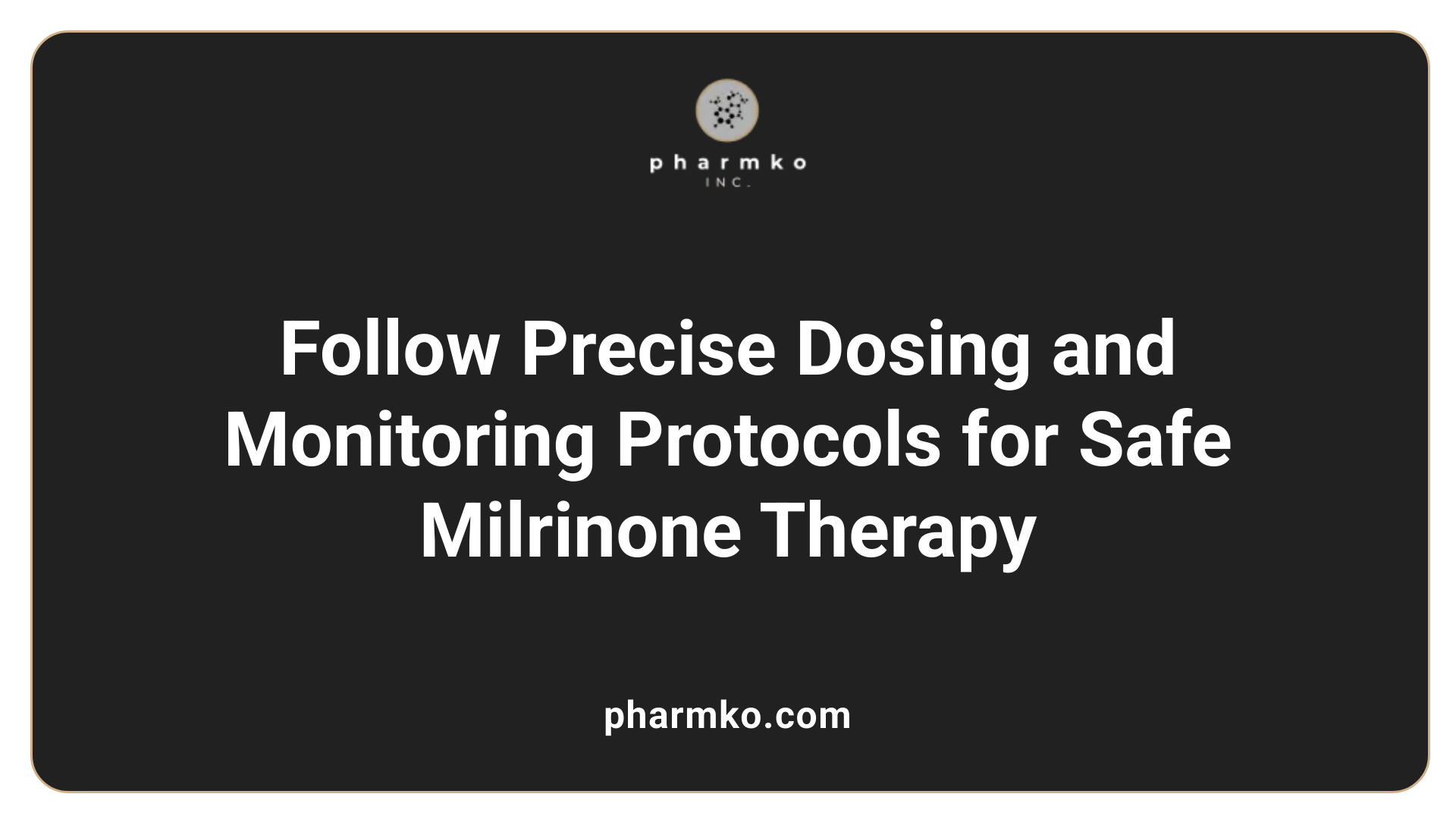
What are the recommended protocols and guidelines for administering IV milrinone?
Administering intravenous milrinone requires adherence to specific protocols to ensure safety and efficacy in patients with advanced heart failure. The treatment typically begins with a loading dose, which ranges from 25 to 50 micrograms per kilogram, administered over 10 minutes. This initial bolus helps rapidly achieve therapeutic levels.
Following the loading dose, a continuous infusion is commenced. The starting infusion rate is usually around 0.125 micrograms per kilogram per minute. Depending on the patient's hemodynamic response and tolerance, the infusion rate can be titrated up to a maximum of 0.75 micrograms per kilogram per minute. Adjustments are generally made every 2 to 4 hours to optimize clinical response and minimize adverse effects.
The infusion should be delivered via a central venous line, utilizing an infusion pump or syringe driver for precise control. In patients who are fluid-restricted, higher concentrations of milrinone—up to 800 micrograms per milliliter—may be used to reduce fluid volume intake.
Close monitoring during infusion is essential. Continuous blood pressure and cardiac rhythm monitoring are mandatory, along with periodic assessments of electrolytes and renal function to detect and manage potential complications early. It is critical to observe for signs of arrhythmias or hypotension, which may necessitate discontinuing the drug.
The usual recommended concentration of milrinone when administered via the central venous route is 200 micrograms per milliliter. Longer-term or outpatient use should be carefully considered, as it is generally discouraged due to the associated risks. All patients undergoing IV milrinone therapy should have their treatment plans reviewed regularly with their cardiologist, especially if therapy is prolonged.
In summary, IV milrinone administration involves precise dosing, vigilant monitoring, and adherence to guidelines to maximize benefits and minimize risks in managing severe heart failure.
Duration of Treatment and Risks
Long-term intravenous (IV) milrinone therapy can extend from several days to over a year depending on the patient’s condition and response to treatment. Studies have demonstrated that some patients with severe congestive heart failure (CHF), especially those refractory to other therapies, tolerate continuous infusions for weeks to months. For instance, patients receiving IV milrinone for six months or longer showed improved hemodynamics, better functional capacity—often moving from NYHA class IV to II/III—and reduced hospitalization frequency.
Despite these benefits, prolonged infusions are not without concern. Evidence indicates that extended use of milrinone may be associated with increased risks, such as arrhythmias, hypotension, and potentially higher mortality, particularly in those with more compromised baseline cardiac function. The proarrhythmic effect raises caution, emphasizing the need for careful cardiac monitoring during long-term therapy.
While early symptomatic and hemodynamic improvements are promising, data on whether long-term milrinone use reduces mortality remains inconclusive. Its primary role appears to be symptom relief and stabilization rather than disease modification.
The decision to continue long-term therapy should be individualized, weighing the potential short-term benefits against the risks of adverse effects. Regular assessment involving cardiologists, continuous monitoring, and tailored treatment plans are essential. Given the current evidence, guidelines recommend diligent surveillance and cautious use, highlighting that more research is necessary to establish definitive safety and efficacy parameters for extended treatment durations.
In summary, long-term IV milrinone therapy can be beneficial for selected patients with advanced heart failure, but it warrants vigilant monitoring and a personalized approach to minimize risks and optimize outcomes.
Mechanisms of Action in Heart Function Improvement
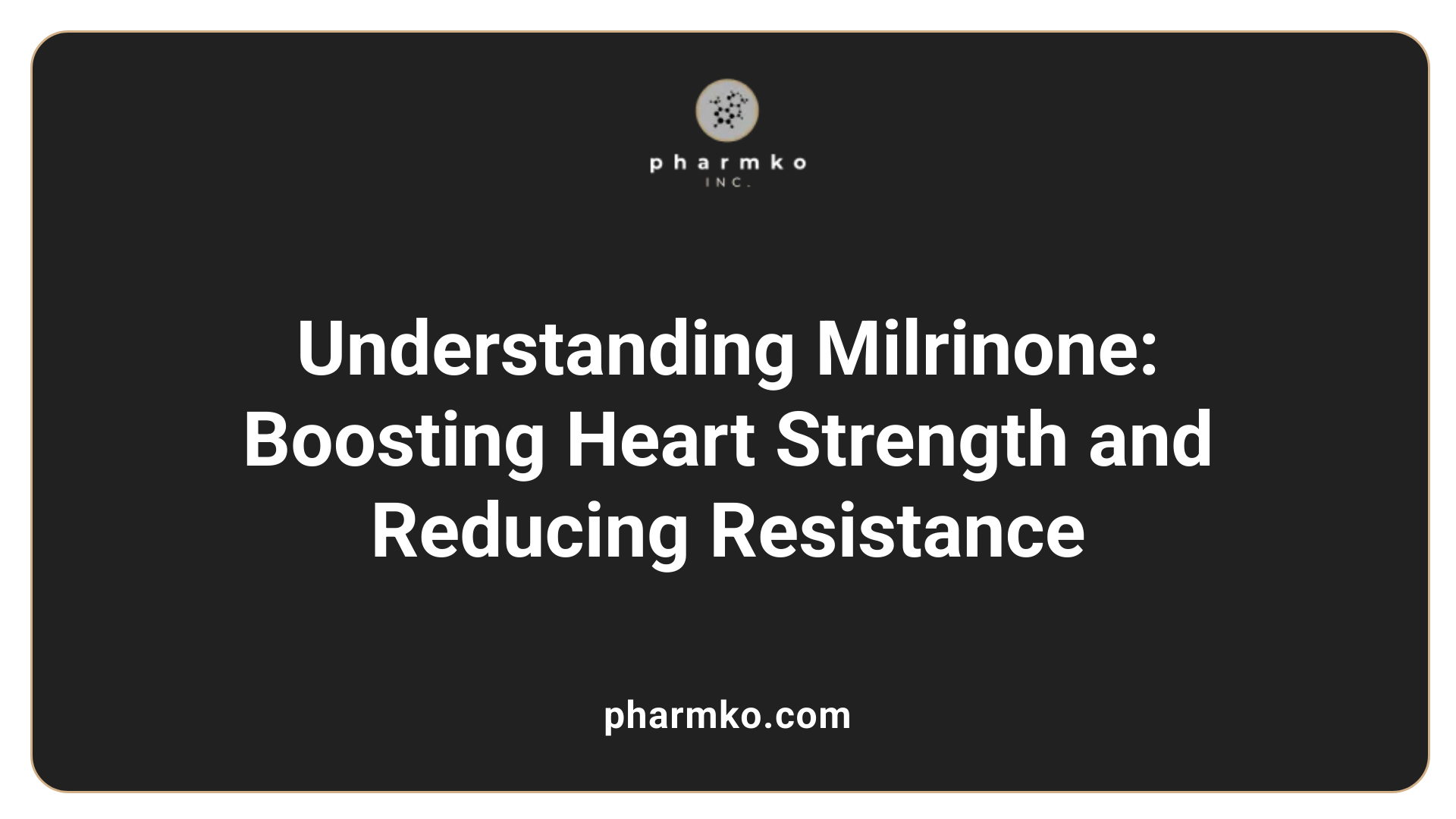 Milrinone works mainly through the inhibition of phosphodiesterase III (PDE-III), an enzyme that breaks down cyclic nucleotides cAMP and cGMP. By blocking PDE-III, milrinone increases the levels of these molecules inside cardiac and vascular smooth muscle cells.
Milrinone works mainly through the inhibition of phosphodiesterase III (PDE-III), an enzyme that breaks down cyclic nucleotides cAMP and cGMP. By blocking PDE-III, milrinone increases the levels of these molecules inside cardiac and vascular smooth muscle cells.
This elevation in cAMP enhances heart muscle contractility, known as positive inotropy. It activates protein kinase A (PKA), which phosphorylates calcium channels, leading to increased calcium entry into cardiac myocytes. The rise in intracellular calcium boosts the strength of each heartbeat.
Moreover, increased cAMP and cGMP cause vasodilation, relaxing blood vessel walls. This vasodilatory effect decreases systemic vascular resistance and pulmonary vascular pressures, easing the heart’s workload.
A significant advantage of milrinone is that it acts independently of β-adrenergic receptors. Therefore, even when these receptors are downregulated in heart failure, milrinone remains effective.
In summary, milrinone improves cardiac performance by enhancing myocardial contractility through calcium dynamics and reducing vascular resistance via vasodilation. These combined effects help improve overall hemodynamics and alleviate symptoms in advanced heart failure.
Side Effects and Contraindications
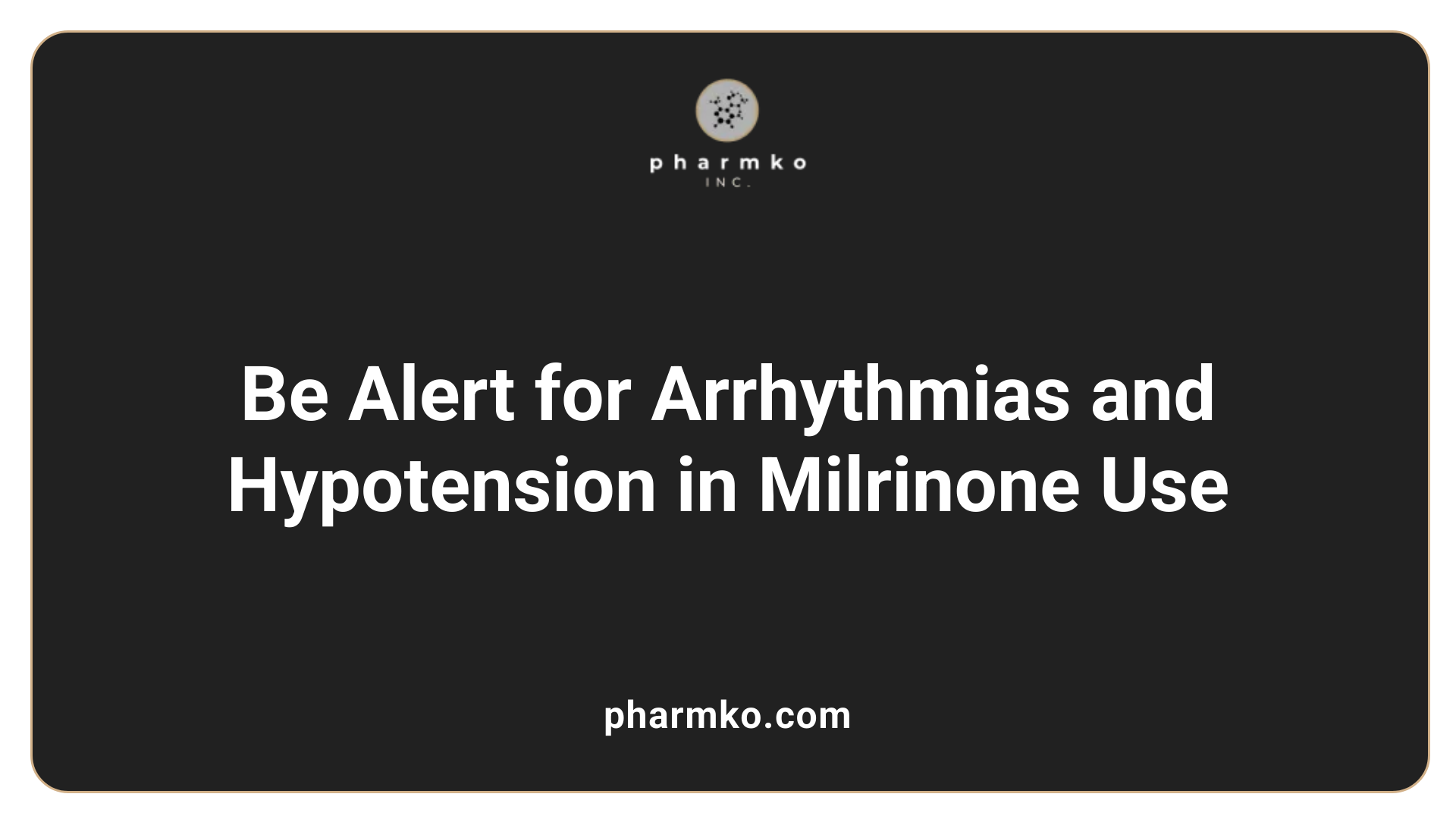
What are the common side effects and contraindications of IV milrinone?
Milrinone, a phosphodiesterase 3 inhibitor used for advanced heart failure, has a range of possible side effects and contraindications. Understanding these is crucial for safe administration.
Common adverse reactions include ventricular and supraventricular arrhythmias, headache, dizziness, hypotension, chest pain, and reactions at the injection site. Less frequently, patients may experience hypokalemia, gastrointestinal disturbances, tremors, skin rashes, bronchospasm, and laboratory abnormalities such as altered liver function tests.
Serious complications can arise, notably ventricular tachyarrhythmias and atrial fibrillation, with rare cases of torsades de pointes reported. These risks underline the importance of continuous hemodynamic monitoring during infusion.
Contraindications for milrinone use include hypersensitivity to the drug, recent myocardial infarction, and severe obstructive valvular disease. Patients with hypertrophic subaortic stenosis or severe renal impairment, especially those with end-stage renal disease, should avoid milrinone or be closely monitored if therapy is deemed necessary.
Special caution is advised in patients with electrolyte imbalances or recent cardiac events, as these conditions can increase the risk of arrhythmias. Given its potent cardiovascular effects, milrinone requires careful, continuous monitoring of cardiac and renal function, and its administration should follow strict medical protocols.
This careful approach ensures the benefits of milrinone in improving hemodynamics outweigh the risks, providing symptomatic relief for those with refractory heart failure.
For further details, searching the term "side effects and contraindications of IV milrinone" can provide updated clinical guidance and recent safety data.
When to Prefer IV Milrinone Over Other Inotropes
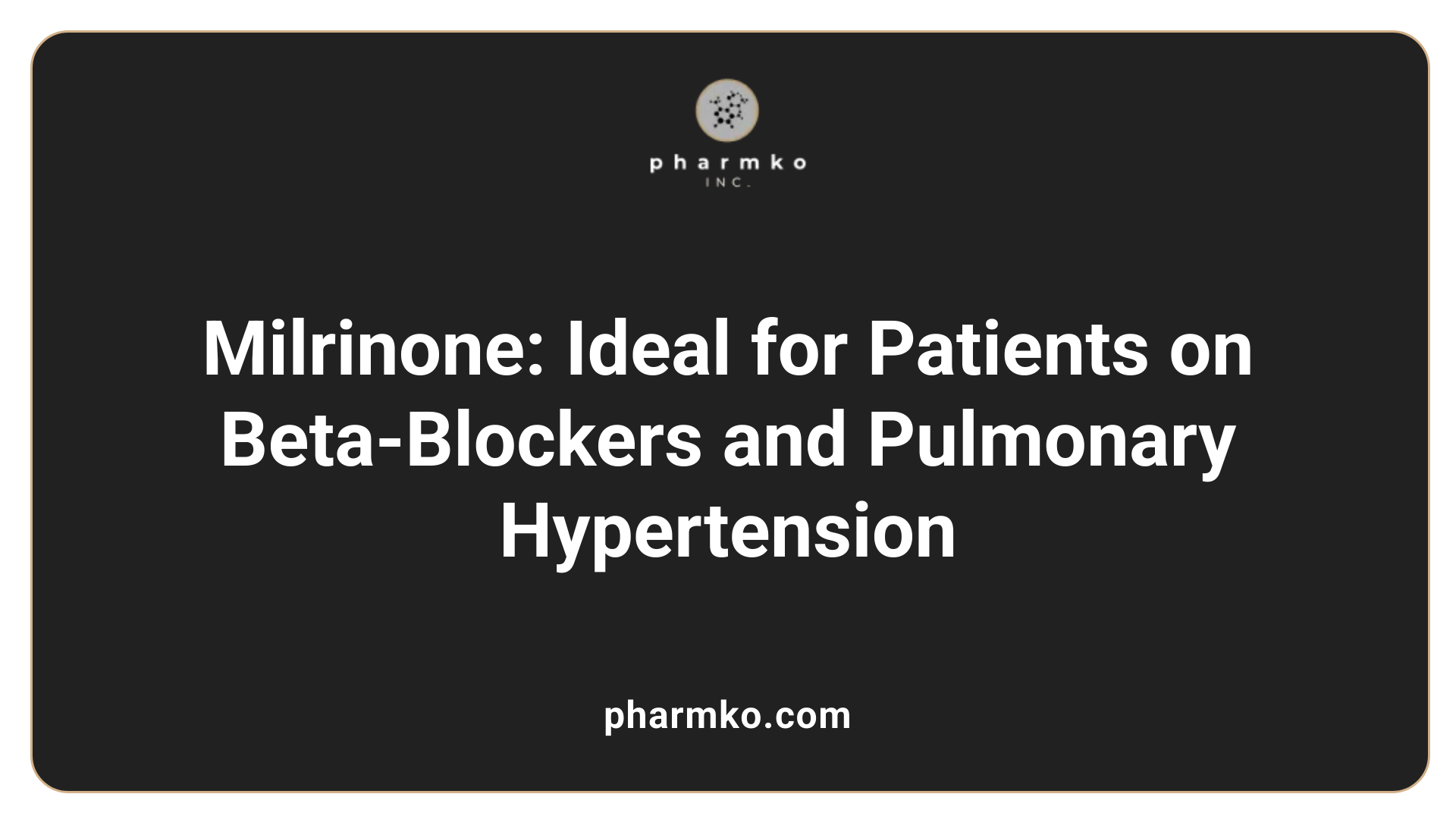 Milrinone is a phosphodiesterase 3 inhibitor that provides positive inotropic and vasodilatory effects, making it a valuable option in certain scenarios of advanced heart failure. Its unique mechanism allows it to increase cardiac output without relying on β-adrenergic pathways, which can be beneficial in specific patient groups.
Milrinone is a phosphodiesterase 3 inhibitor that provides positive inotropic and vasodilatory effects, making it a valuable option in certain scenarios of advanced heart failure. Its unique mechanism allows it to increase cardiac output without relying on β-adrenergic pathways, which can be beneficial in specific patient groups.
One of the primary situations where IV milrinone is favored over other inotropes like dobutamine is in patients who are already on β-adrenergic blockers. Since milrinone’s inotropic action does not depend on β-receptor stimulation, it remains effective even when these receptors are blocked by medication. This makes it especially useful in patients with chronic heart failure who are on β-blocker therapy, a common long-term treatment.
Additionally, milrinone offers advantages for patients with pulmonary hypertension or right ventricular failure. Its vasodilatory properties help reduce pulmonary vascular resistance, easing right heart strain and improving overall hemodynamics. This effect is particularly important in patients with elevated pulmonary artery pressures who might otherwise face worsening right-sided failure.
Clinical studies also demonstrate improved long-term survival and fewer hypertensive episodes when milrinone is used compared to dobutamine. It can be administered as a continuous infusion, providing sustained hemodynamic support. Despite its benefits, clinicians should remain cautious of potential side effects, such as hypotension, resulting from systemic vasodilation.
Overall, IV milrinone is especially indicated in patients with advanced heart failure who require inotropic support but cannot benefit from β-adrenergic agents. It’s suitable in scenarios of pulmonary hypertension and right ventricular failure, offering a combination of inotropic and vasodilatory effects that support cardiac function and reduce pulmonary pressures.
Post-Care Management and Discharge Planning
What are the considerations for discharge and outpatient management of patients on IV milrinone?
Discharging patients on intravenous (IV) milrinone requires careful planning and coordination among healthcare providers to ensure patient safety and effective management at home or outpatient settings.
A comprehensive assessment includes reviewing the patient's hemodynamic stability, ongoing need for inotropic support, and overall clinical condition. Regular follow-up visits with a cardiologist are essential, ideally at least every two weeks, to reassess therapy efficacy and adjust treatment as needed.
Implementing a discharge checklist based on the Transition of Care Model has proven beneficial. This checklist helps organize tasks, streamline discharge procedures, and reduce the average discharge time by about an hour.
Nurses play a crucial role in this process. Those caring for patients on IV milrinone should be accredited and trained through specialized programs, such as the Inotrope Infusion Learning Package. Proper caregiver education is also vital, especially when managing therapy at home.
For patients, particularly children, central venous access via a catheter or peripherally inserted central catheter (PICC) line facilitates outpatient treatment. Monitoring for potential complications such as infection, thrombosis, or pump malfunctions is critical.
In pediatric cases, outpatient milrinone therapy has shown to be safe and beneficial, often reducing hospital stays and supporting palliative care or bridging to a transplant.
Overall, vigilant follow-up, patient education, and adherence to safety protocols are necessary to optimize outcomes in patients discharged on home IV milrinone therapy.
Clinical Evidence and Outcomes with IV Milrinone
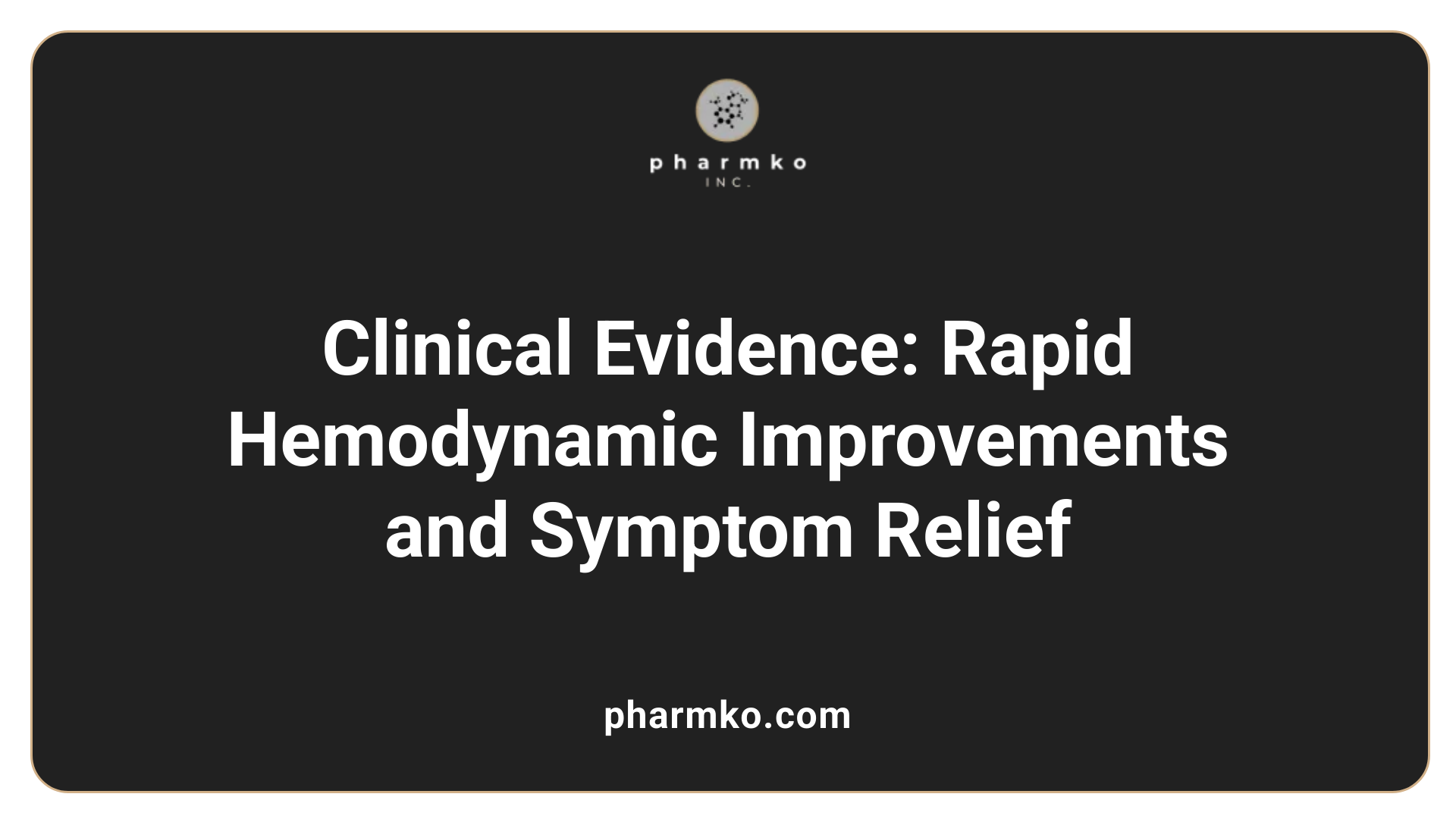
What evidence supports the efficacy and safety of IV milrinone in managing heart failure?
Numerous clinical studies confirm that intravenous (IV) milrinone effectively enhances cardiovascular function in patients with advanced heart failure. These studies highlight rapid and sustained improvements in heart performance and symptom relief.
Hemodynamically, milrinone significantly increases cardiac output, with average increases ranging from 24% to 42%. It also reduces pulmonary wedge pressure by 24% to 33% and decreases vascular resistance by 15% to 31%. These changes reflect improved blood flow and decreased workload on the heart.
Patients often experience notable symptom improvements. Studies report reductions in dyspnea (61%), orthopnea (63%), edema (62%), and fatigue (40%). This symptomatic relief, combined with better hemodynamics, results in enhanced functional status.
In terms of safety, most research indicates that IV milrinone is well tolerated when used appropriately. However, potential adverse events include ventricular arrhythmias and hypotension, which require careful monitoring. Studies involving long-term infusions—lasting up to 48 hours or longer—show that patients generally maintain hemodynamic gains with minimal side effects.
Extended infusion studies reveal that some patients can remain on milrinone therapy for weeks or months. These individuals often display improved New York Heart Association (NYHA) functional classes and experience fewer hospital admissions. In certain cases, long-term IV milrinone has been associated with better organ function and survival prospects, though it does not definitively reduce mortality.
Overall, these findings support the clinical utility of IV milrinone as a safe and effective short- and long-term option for managing severe heart failure, especially to stabilize patients and improve quality of life.
| Hemodynamic Parameters | Response Range | Additional Details |
|---|---|---|
| Cardiac Index Increase | 24% to 42% | Rapid response with initial doses |
| Pulmonary Wedge Pressure | Decrease 24% to 33% | Significant reduction observed within hours |
| Systemic Vascular Resistance | Decrease 15% to 31% | Contributes to improved cardiac efficiency |
| Symptom Improvements | Percentage of Patients | Notes |
|---|---|---|
| Dyspnea | 61% | Reduced after infusion |
| Orthopnea | 63% | Marked relief noted |
| Edema | 62% | Decreased by therapy |
| Fatigue | 40% | Reported as improved in patient assessments |
| Patient Outcomes | Findings | Additional Comments |
|---|---|---|
| Tolerance | Generally well tolerated with monitoring | Arrhythmias and hypotension are potential risks |
| Long-term infusion response | Sustained hemodynamic improvements up to 48 hours or more | Some patients maintain better functional status and fewer hospitalizations |
| Overall mortality impact | Not definitively reduced | More research needed to assess long-term survival benefits |
This comprehensive evidence underscores IV milrinone’s role in managing severe heart failure, highlighting its capacity for rapid stabilization, symptom relief, and potential long-term benefits when used judiciously.
Special Considerations and Future Directions
Research gaps remain regarding the long-term effects of IV milrinone, especially its impact on mortality rates and overall quality of life for heart failure patients. Current studies highlight its effectiveness as a short-term stabilizer or bridge to advanced therapies like transplant, yet its long-term safety profile is less clear.
Potential for long-term use of milrinone is promising but warrants caution. While some patients tolerate prolonged therapy with noticeable hemodynamic improvements, concerns about adverse effects such as arrhythmias and possible increased mortality continue to influence clinical decision-making. Therefore, establishing precise protocols for duration and dosage—particularly in outpatient settings—is an area for ongoing investigation.
Innovations in care models have significantly improved the safety and efficiency of milrinone therapy. The implementation of discharge checklists based on transition-of-care principles has reduced discharge times and enhanced nurse confidence, which benefits both patients and healthcare providers. These models foster better organization, promote safety, and support patient education.
Expanding outpatient management, especially for pediatric patients, shows great potential. Children requiring long-term IV therapy for congenital or acquired heart disease can be safely treated at home, reducing hospitalization costs and improving quality of life. However, this approach demands rigorous monitoring and skilled nursing support.
Looking ahead, future research should explore optimal treatment durations, combination therapies with β-blockers, and improved pump or infusion device technologies. Emphasizing patient safety, minimizing risks, and personalizing therapy are crucial goals.
Overall, continuous scientific efforts and clinical trials are necessary to develop evidence-based guidelines. These efforts will help refine patient selection, optimize therapeutic strategies, and fully harness the potential of IV milrinone in managing advanced heart failure.
Advancing Heart Failure Management
IV milrinone remains a valuable tool in the acute management and long-term support of severe heart failure, offering rapid hemodynamic improvements and symptom relief. Its efficacy, however, must be balanced against potential risks, requiring careful patient selection, vigilant monitoring, and adherence to established protocols. Emerging evidence on long-term use and outpatient applications holds promise for broader, more effective management strategies, with ongoing research poised to refine its role further. As our understanding deepens, IV milrinone is poised to become an integral component of personalized heart failure therapy, driving better patient outcomes and advancing contemporary cardiac care.
References
- Intravenous Milrinone in Treatment of Advanced Congestive Heart ...
- Long-Term Ambulatory Intravenous Milrinone Therapy in Advanced ...
- [PDF] Milrinone Infusion - Management
- [PDF] Enhancing Discharge Process for Home IV Milrinone Patients With ...
- Role of Milrinone in the Management of Congestive Heart Failure
- Hemodynamic and clinical benefits with intravenous milrinone in ...
- Milrinone as Compared with Dobutamine in the Treatment of ...
- Efficacy and safety of sustained (48 hour) intravenous infusions of ...
- Efficacy and Safety of Milrinone in Preventing Low Cardiac Output ...
- Continuous Intravenous Milrinone Therapy in Pediatric Outpatients













